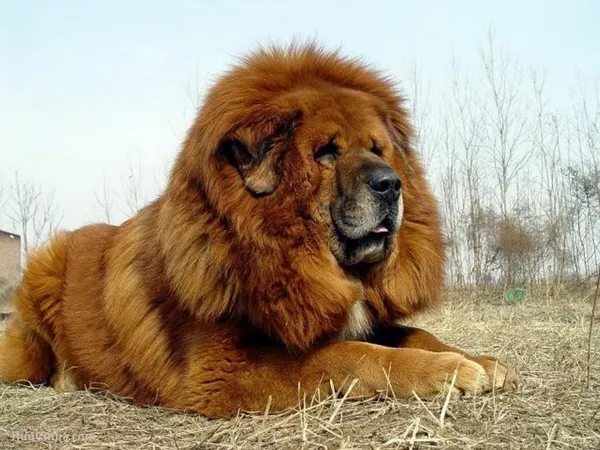The Tibetan Mastiff, a majestic and imposing breed, has earned its reputation as the world’s most expensive dog. Hailing from the remote regions of the Himalayas, this ancient breed has captivated dog enthusiasts and wealthy collectors alike with its regal appearance and rare status. In this article, we will explore the factors that contribute to the exorbitant price tag attached to Tibetan Mastiffs, shedding light on why they have become the epitome of canine luxury.
1. Ancient Heritage and Rarity
The Tibetan Mastiff boasts a rich history that spans over thousands of years, dating back to ancient Tibet and China. Originally bred to guard livestock and monasteries in the harsh Himalayan terrain, these dogs were revered for their loyalty, intelligence, and protective instincts. Due to their limited population and restricted breeding practices, genuine Tibetan Mastiffs are exceedingly rare, and this scarcity contributes significantly to their high price.
2. Imposing Appearance
One cannot ignore the awe-inspiring presence of the Tibetan Mastiff. With its large, muscular frame, thick double coat, and bushy tail, the breed exudes an aura of power and elegance. Its distinctive lion-like mane around the neck further adds to its regal demeanor, making it a prized possession for those seeking to own a dog that stands out from the crowd.
3. Celebrity Endorsements
In recent years, Tibetan Mastiffs have gained popularity among celebrities and affluent individuals, further fueling their demand and price. As these high-profile figures showcase their love for this breed on social media and in public, they inadvertently contribute to the breed’s allure, creating a perception of exclusivity and luxury.
4. Health Testing and Certification
Reputable breeders and enthusiasts invest heavily in ensuring the health and well-being of Tibetan Mastiffs. These dogs undergo rigorous health testing to screen for genetic disorders and hereditary conditions, ensuring that they are in optimal health before being sold. Such extensive medical evaluations add to the cost of acquiring a Tibetan Mastiff, but they also offer peace of mind to potential owners, knowing they are getting a healthy and well-cared-for canine companion.
5. Training and Socialization
Tibetan Mastiffs require specialized training and socialization due to their strong protective instincts. Proper training is vital to ensure they develop into well-behaved and balanced dogs. The investment of time and effort in providing early training and socialization by breeders increases the overall cost of owning a Tibetan Mastiff.
6. Breeding Challenges
Breeding Tibetan Mastiffs is no easy task. Mating pairs must be selected carefully to preserve the breed’s unique characteristics, which includes maintaining their ancient lineage and bloodlines. The difficulty in finding compatible breeding pairs and ensuring successful pregnancies further adds to the costs associated with producing purebred Tibetan Mastiffs.
7. High Maintenance Requirements
The luxurious appearance of Tibetan Mastiffs comes with high maintenance needs. Their thick, double coat requires regular grooming to prevent matting and tangles. Additionally, these dogs have a tendency to drool, which necessitates more frequent cleaning and care. Their large size also means they consume larger quantities of food, leading to higher ongoing expenses.
8. International Demand
The demand for Tibetan Mastiffs has transcended borders, with enthusiasts and collectors from around the world vying to own one of these magnificent dogs. However, importing a Tibetan Mastiff from its native region involves significant costs, including shipping fees, quarantine expenses, and import taxes. These costs are often passed on to prospective buyers, further escalating the breed’s price.
9. Cultural and Spiritual Significance
In Tibet and parts of China, Tibetan Mastiffs hold deep cultural and spiritual significance. They are regarded as symbols of prosperity, good fortune, and protection against evil spirits. Consequently, owning a Tibetan Mastiff is a matter of prestige for some, leading to higher demand and inflated prices, especially in the regions where they are considered a status symbol.
10. Breeding Rights and Show Quality
For breeders who aspire to produce show-quality Tibetan Mastiffs or those seeking to breed their own dogs, the costs can be even higher. Breeding rights and show-quality specimens come with a premium price tag, as these dogs are expected to meet strict standards set by kennel clubs and breed organizations.
Conclusion
The Tibetan Mastiff’s reign as the most expensive dog is a result of its unparalleled history, appearance, and cultural significance, coupled with the challenges of breeding and maintaining these majestic animals. As demand continues to rise, so does their price, making them an exclusive and sought-after breed for dog enthusiasts and collectors alike. However, before considering owning a Tibetan Mastiff, prospective owners must carefully evaluate their ability to provide the necessary care, attention, and resources required to ensure the well-being of these magnificent creatures.


